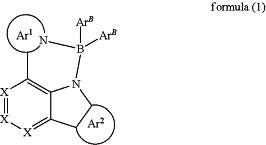| CPC C07F 5/02 (2013.01) [C07F 5/025 (2013.01); H10K 50/11 (2023.02); H10K 85/654 (2023.02); H10K 85/657 (2023.02); H10K 50/15 (2023.02); H10K 50/16 (2023.02); H10K 2101/10 (2023.02)] | 17 Claims |
|
1. A compound of the formula (1),
 where the following applies to the symbols and indices used:
Ar1 is a heteroaryl group comprising at least one nitrogen which is represented in formula (1), having 5 to 30 aromatic ring atoms, which may be substituted by one or more radicals R1;
Ar2 stands for an aryl or heteroaryl group having 5 to 30 aromatic ring atoms, which may be substituted by one or more radicals R1;
ArB is, on each occurrence, identically or differently, an aromatic or heteroaromatic ring system having 5 to 60 aromatic ring atoms, which may be substituted by one or more radicals R3;
X stands, on each occurrence, identically or differently, for CR2 or N; or two adjacent groups X stand for a group of formula (X-1),
 where the dashed bonds in formula (X-1) indicate the bonding of the corresponding adjacent groups X to the structure;
V is on each occurrence, identically or differently, CR2 or N;
R1, R2, R3 stand on each occurrence, identically or differently, for H, D, F, Cl, Br, I, CHO, CN, C(═O)Ar3, P(═O)(Ar3)2, S(═O)Ar3, S(═O)2Ar3, N(Ar3)2, NO2, Si(R4)3, B(OR4)2, OSO2R4, a straight-chain alkyl, alkoxy or thioalkyl groups having 1 to 40 C atoms or branched or a cyclic alkyl, alkoxy or thioalkyl groups having 3 to 40 C atoms, each of which may be substituted by one or more radicals R4, where in each case one or more non-adjacent CH2 groups may be replaced by R4C═CR4, C≡C, Si(R4)2, Ge(R4)2, Sn(R4)2, C═O, C═S, C═Se, P(═O)(R4), SO, SO2, O, S or CONR4 and where one or more H atoms may be replaced by D, F, Cl, Br, I, CN or NO2, an aromatic or heteroaromatic ring systems having 5 to 60 aromatic ring atoms, which may in each case be substituted by one or more radicals R4, or an aryloxy groups having 5 to 60 aromatic ring atoms, which may be substituted by one or more radicals R4; where two adjacent substituents R1, two adjacent substituents R2 and/or two adjacent substituents R3 may form an aliphatic or aromatic ring system together, which may be substituted by one or more radicals R4; and where one substituent R1 of the group Ar1 and one substituent R2 of the adjacent 6-membered ring comprising the groups X may form an aliphatic or aromatic ring system together;
Ar3 is, on each occurrence, identically or differently, an aromatic or heteroaromatic ring system having 5 to 60 aromatic ring atoms, which may in each case also be substituted by one or more radicals R4; and
R4 stands on each occurrence, identically or differently, for H, D, F, Cl, Br, I, CN, a straight-chain alkyl, alkoxy or thioalkyl groups having 1 to 20 C atoms or branched or cyclic alkyl, alkoxy or thioalkyl groups having 3 to 20 C atoms, where in each case one or more non-adjacent CH2 groups may be replaced by SO, SO2, O, S and where one or more H atoms may be replaced by D, F, Cl, Br or I, or an aromatic or heteroaromatic ring system having 5 to 24 C atoms.
|